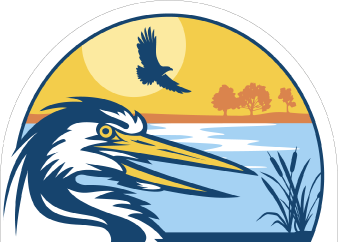
Most of the cavity nesting birds at Iroquois Refuge had a good season this year. Nesting season is over but there is still work to do. Nest boxes and martin houses need to be cleaned out and closed for the winter and gourds taken down, washed and stored for the winter. Repair of any nest boxes will be undertaken and plans will be made for the 2020 nesting season. The winter is a good time to study and analyze our data and findings for 2019. We can then determine what changes would enhance nesting attempts and fledging success for the next breeding season.
Here is a summary of the 2019 season:
Click here to become a member!
Click here to donate!
Tree Swallows had a good year. Their totals for this year are as follows: 91nests, 510 eggs, 440 hatched and 416 fledged. This was up 14% from last year. We banded 431 of these chicks and 27 adult tree swallows. We also recaptured 5 adult birds, all of which had been banded by us in previous years. These numbers are about average as the cold spring and House Sparrows caused a negative impact on the degree of success. We lacked coverage for monitoring early in the season but two Refuge Volunteers, Mary Jane Shonn and Janie Mellas were a big help during the banding portion of the year.
Bluebirds were also up 1.5% this year. Their totals are as follows: 57nests, 232 eggs, 156 hatchlings and 140 fledglings. We banded 144 of these hatchlings. The numbers are low and here again the cold spring, habitat loss and lack of sufficient house sparrow control caused several losses. Note that only 67% of the eggs hatched probably caused by the cold wet spring. Normal hatch rate is around 80%. We continue to try new methods of house sparrow control but have not yet found an effective method. I keep up dated on new findings by the New York State and the North American Bluebird Societies on this issue.
American Kestrels continued their low productivity rate. This is the second year in a row that we have not had an American Kestrel nest on the Refuge. There was a successful nest which fledged four kestrels on the John White WMA which is the old game farm and another new nest on the Tonawanda WMA that fledged 3 chicks. We have attempted to attract kestrels to nest at other locations on the Refuge but have not been successful in over seven years. American Kestrels are declining in the North East (The New England States) with populations down over 85percent since the 1960s according to the American Kestrel Partnership. We need to do more work on this species to help reverse this trend. Additional nest boxes and enhancements are planned for 2020.
The Purple Martins had a record year at the Refuge and adjoining NYS Wildlife Management Areas. The Purple Martin totals for 2019 are as follows: 189 nests, 919 eggs, 756 hatchlings and 702 fledged. We banded 725 of the hatchlings and 11 adults that were captured in the nest cavities. The hatchlings were banded with USFWS band on the left leg. The adults were also banded with the USFWS band on their left leg. Of the latter, three of the birds were SY (Second Year) females, seven were ASY (After second year) females and the other one was an ASY male. All of these birds came from sites other than ours. We captured 10 adult birds with green band numbers that had been banded at one of our sites and either returned to the same site or moved to another one of the sites that we manage. Five of these bird were ASY males captured from May 1st to May 16. The other five were ASY females captured May 11 thru June 19. Several other green bands were observed but we could not read the numbers. If you see or hear of any green banded martins please record the date and location and report it to the Refuge. This year there were 5 martins identified by our green bands at other locations. One was in Lyndonville, 2 were in Middleport, One was on Saunders Settlement Road in Lockport and one was at PMCA in Erie, PA. The one captured in Lockport was banded 6/27/12. This bird had made 7 round trips to Brazil and back. Over 56,000 miles in migration alone.
We also fledged 53 House Wrens. In total we fledged 1318 birds from our nest boxes and applied 1307 bands.
We continued to assist in the parasite and provisioning study being conducted by Heather Williams, a PHD student at the State University of New York at Buffalo. This season data was collected with our camera system on 11 nests involving provisioning of food to the chicks by the adults. We are looking forward to next year when some of the results of the 3 year parasite study will be made available.
This research study has been very interesting to work on and we look forward to hearing more about the analysis of the results.
In summary, I want to thank all the core leaders and assistants who contributed this year. Heather and the UB under-Grads Samantha Wilcox, Ramya Sridar and Alyssa Gooding were the core group helping with the martin monitoring and banding. Mary Jane Shoon and Janie Mellas did a lot of the Bluebird and Tree Swallow monitoring and banding. In total 28 people helped with this program and made it all happen. These included volunteers, Staff, YCC youth and their leader, interns, students and other interested persons wanting to learn about birds. We also had 12 people attend the Public day nest check and banding event. Overall this was a great year for both the birds and the persons involved.
A big THANK YOU to everyone.

